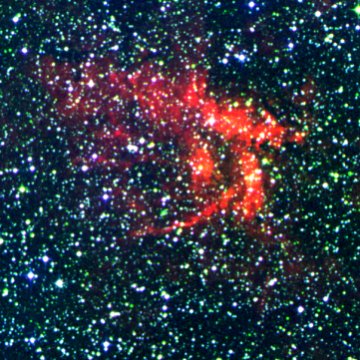RCW 122
Coordinates: (348.9°, -1.1°)
[ Catalog | Explorer | SIMBAD ]
A 2012 study used radio parallax to determine the distance to a maser in the direction of RCW 122 as 3380 parsecs, strongly implying that this is the distance of the entire Havlen-Moffat 1 star formation region.
RCW 122 separates into at least two distinct sources in infrared. The brightest one by far is IRAS 17167-3854, which is sometimes further subdivided into RCW 122A and RCW 122B. Dutra and colleagues locate the infrared cluster [DBS2003] 119 in this direction at 2000 parsecs. A distinct smaller nebula to the northwest in galactic coordinates is IRAS 17158-3901, also known as RCW 122C. These sources are ionised by several O-stars, including one as bright as O4.
A 2008 paper concludes that RCW 121 and RCW 122 are embedded in a 1.2 million solar mass molecular cloud and both nebulae are likely ionised by several O7 V class stars.
The larger region around RCW 121, RCW 122 and RCW 123 is spectacular in infrared. This Spitzer image shows only a part of this region. While not as detailed, this MSX image shows a wider view of the region in which the compact HII regions RCW 121 and 122 are seen to be bright knots at the rim of a vast star forming cavity centred on the ionising cluster Havlen-Moffat 1 and filled by the diffuse HII region RCW 123.
RCW 122 and RCW 123 are probably ionised by stars in the Havlen-Moffat No. 1 cluster.[2]
The massive star formation region RCW 122 is ionised by several O-stars, including one as bright as O4.[3]
Dutra et.al. infrared star cluster catalog. [4]
Notes
1. ^ Arnal, E. M., Duronea, N. U., & Testori, J. C. (2008). "Molecular gas associated with RCW 121 and RCW 122", Astronomy and Astrophysics, Vol. 486, 807-818. [2008A&A...486..807A]
2. ^ Vázquez, R. A. & Baume, G. (2001). "The open cluster Havlen-Moffat No. 1 revisited", Astronomy and Astrophysics, Vol. 371, 908-920. [2001A&A...371..908V]
3. ^ Ghosh, S. K., Iyengar, K. V. K., Rengarajan, T. N., et al. (1989). "Far-infrared (120-300 micron) observations of southern H II regions", The Astrophysical Journal Supplement Series, Vol. 69, 233-239. [1989ApJS...69..233G]
4. ^ Dutra, C. M., Bica, E., Soares, J., et al. (2003). "New infrared star clusters in the southern Milky Way with 2MASS", Astronomy and Astrophysics, Vol. 400, 533-539. [2003A&A...400..533D]
Links
[ DSS | ADS | ADS Abstract ]
map | book | blog | gallery | sources

This image was created using the POSS-II/UKSTU data of the Digitized Sky Survey and SuperCOSMOS using the process described here.
According to my correspondence with the Royal Observatory Edinburgh and the Space Telescope Science Institute, I am allowed to use the POSS-II/UKSTU data to create and display images for non-commercial purposes so long as I include this fine print for the SuperCOSMOS data:
Use of these images is courtesy of the UK Schmidt Telescope (copyright in which is owned by the Particle Physics and Astronomy Research Council of the UK and the Anglo-Australian Telescope Board) and the Southern Sky Survey as created by the SuperCOSMOS measuring machine and are reproduced here with permission from the Royal Observatory Edinburgh.
and this acknowledgement taken from the DSS site:
The Digitized Sky Surveys were produced at the Space Telescope Science Institute under U.S. Government grant NAG W-2166. The images of these surveys are based on photographic data obtained using the Oschin Schmidt Telescope on Palomar Mountain and the UK Schmidt Telescope. The plates were processed into the present compressed digital form with the permission of these institutions.
The Second Palomar Observatory Sky Survey (POSS-II) was made by the California Institute of Technology with funds from the National Science Foundation, the National Geographic Society, the Sloan Foundation, the Samuel Oschin Foundation, and the Eastman Kodak Corporation.
The UK Schmidt Telescope was operated by the Royal Observatory Edinburgh, with funding from the UK Science and Engineering Research Council (later the UK Particle Physics and Astronomy Research Council), until 1988 June, and thereafter by the Anglo-Australian Observatory. The blue plates of the southern Sky Atlas and its Equatorial Extension (together known as the SERC-J), as well as the Equatorial Red (ER), and the Second Epoch [red] Survey (SES) were all taken with the UK Schmidt.
The "Second Epoch Survey" of the southern sky was made by the Anglo-Australian Observatory (AAO) with the UK Schmidt Telescope. Plates from this survey have been digitized and compressed by the ST ScI. The digitized images are copyright ? 1993-5 by the Anglo-Australian Observatory Board, and are distributed herein by agreement.
The "Equatorial Red Atlas" of the southern sky was made with the UK Schmidt Telescope. Plates from this survey have been digitized and compressed by the ST ScI. The digitized images are copyright ? 1992-5, jointly by the UK SERC/PPARC (Particle Physics and Astronomy Research Council, formerly Science and Engineering Research Council) and the Anglo-Australian Telescope Board, and are distributed herein by agreement.
The compressed files of the "Palomar Observatory - Space Telescope Science Institute Digital Sky Survey" of the northern sky, based on scans of the Second Palomar Sky Survey are copyright ? 1993-1995 by the California Institute of Technology and are distributed herein by agreement. The compressed files of the "Palomar Observatory - Space Telescope Science Institute Digital Sky Survey" of the northern sky, based on scans of the Second Palomar Sky Survey are copyright ? 1993-1995 by the California Institute of Technology and are distributed herein by agreement.